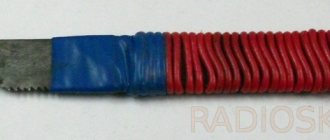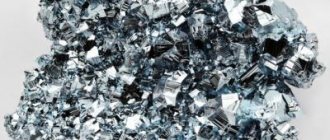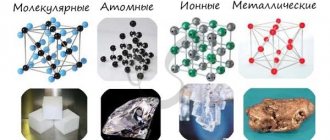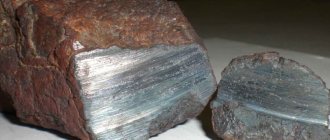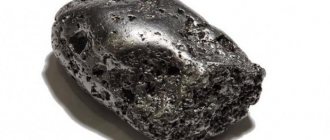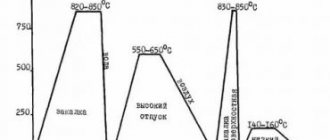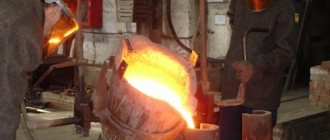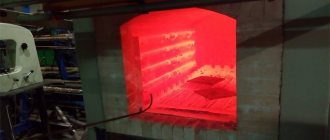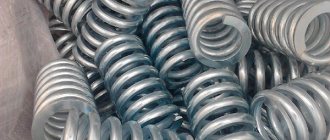IRON, Fe (a. iron; n. Eisen; f. fer; i. hierro), is a chemical element of group VIII of the periodic system of Mendeleev’s elements, atomic number 26, atomic mass 55.847. Natural iron consists of 4 stable isotopes: 54Fe (5.84%), 56Fe (91.68%), 57Fe (2.17%) and 58Fe (0.31%). Radioactive isotopes 52Fe, 53Fe, 55Fe, 59Fe, 60Fe were obtained. Iron has been known since prehistoric times. For the first time, man probably became acquainted with meteorite iron, because. The ancient Egyptian name for iron, beni-pet, means heavenly iron. In Hittite texts there is a mention of iron as a metal that fell from the sky.
- Physical properties
- Chemical properties
- Being in nature
- Receipt
- Application and Use
Physical properties of iron
Iron is a silver-gray ductile metal. Crystal modifications a-, g- and d-Fe were discovered in 1868 by D.K. Chernov. Up to f 1042K, the crystal lattice is body-centered cubic, the lattice parameter a = 0.2 86645 nm is a-Fe, between t 1173 and 1673 K is face-centered, a = 0.3 637 nm is g-Fe, above f 1673 K is volume-centered. centered, a = 0.2 925 nm - d-Fe, between f 1042 and 1173 K - body-centered, a = 0.2 895 nm - d-Fe (sometimes called beta - b). Modifications g- and d-Fe are paramagnetic. The physical properties of iron depend on the content of impurities. With a total impurity content of less than 0.01% by mass - density (293.15 K) 7.84•103 kg/m3; tnл1536°С, melting enthalpy 13.77 kJ/mol; boiling point 2880°C; enthalpy of evaporation 350.02 kJ/mol; thermal conductivity coefficient (298K) 74.04 W/m K; electrical resistivity (293 K) 9.7•10-8 Ohm/m; temperature coefficient of electrical resistance (273-373 K) 6.51•10-3K-1, relative elongation 45-55%; temperature coefficient of linear expansion (293 K) 11.7•10-6K-1, Brinell hardness 350-450 MPa; Young's modulus 190-210•103 MPa; shear modulus 8.4•10-3 MPa; short-term tensile strength 170-210 MPa, yield strength 100 MPa; impact strength 300 MPa; average specific heat capacity (273-1273 K) 640.57 J/kg•K, molecular volume 7.093•10-6 m3/mol.
Chemical properties of iron
Iron oxidation states +2, +3, +1, +4, +6. The most stable compounds are divalent and trivalent iron. Chemically pure iron at normal temperatures is resistant to oxidation in air and water. In the absence of moisture, it does not react noticeably with oxygen, sulfur, bromine, chlorine; in humid air it oxidizes, becoming covered with rust FeO•nH2O. When heated in the presence of water, it oxidizes to form Fe3O4 (up to 845K) or FeO (above 845K) and the release of hydrogen. When heated in dry air at 473-573K, it becomes covered with a thin oxide film, which protects the metal from corrosion (the technical method of protecting iron from corrosion is bluing). Reacting at elevated temperatures and in the presence of water with S, P, Cl, N, Ti, it forms iron halides, sulfides, phosphides, nitrides, and titanides. It dissolves well in dilute acids and is practically insoluble in alkalis. When interacting with concentrated acids H2SO4 and HNO3, it becomes covered with a protective oxide film. Tends to form complex compounds. Iron oxide FeO exhibits basic properties, oxide Fe2O3 is amphoteric, has a weakly expressed acidic function, reacts with more basic oxides, forming ferrites Fe2O3•nMeO, which have ferromagnetic properties. Acidic properties are also expressed in Fe+6, which exists in the form of ferrates, salts of ferric acid not isolated in the free state. Aqueous solutions of iron salts have an acidic reaction due to hydrolysis. Aqueous solutions of ferrous iron salts are unstable in air; Fe2+ is oxidized to Fe3+. The solubility of carbon in a-Fe at room temperature is 2•10-5%, at t 1110K 0.02%; 2.11% carbon dissolves in gF at t 1426K. A solid solution of carbon in g-Fe is called austenite, and a solid solution of carbon in a-Fe is called ferrite. When austenite is quenched, martensite, a supersaturated solid solution of carbon, is formed. The combination of hardening with heating to relatively low temperatures makes it possible to give the steel the required combination of hardness and ductility.
Crystal lattices
The crystal lattice is the spatial arrangement of atoms or ions in a crystal. The points of the crystal lattice at which atoms or ions are located are called lattice nodes.
Crystal lattices are divided into molecular, atomic, ionic and metallic.
It is very important not to confuse the type of chemical bond and crystal lattice. Remember that crystal lattices reflect the spatial arrangement of atoms.
Molecular crystal lattice
Molecules are located at the nodes of a molecular lattice. Under normal conditions, most gases and liquids have a molecular lattice. Bonds are most often covalent polar or nonpolar.
The classic example of a substance with a molecular lattice is water, so associate the properties of these substances with water. Substances with a molecular lattice are fragile, have low hardness, are volatile, fusible, capable of sublimation, and are characterized by low boiling points.
Examples: NH3, H2O, Cl2, CO2, N2, Br2, H2, I2. I would especially like to mention white phosphorus, orthorhombic, plastic and monoclinic sulfur, and fullerene. We studied these allotropic modifications in detail in an article devoted to the classification of substances.
Ionic crystal lattice
At the sites of the ionic lattice there are atoms connected by ionic bonds. This type of lattice is characteristic of substances that have ionic bonds: metal salts, oxides and hydroxides.
Associate this series of substances with table salt - NaCl. Substances with an ionic lattice have high melting and boiling points, are easily soluble in water, brittle, solid, their solutions and melts conduct electric current.
Examples: NaCl, MgCl2, NH4Br, KNO3, Li2O, Na3PO4.
Metal crystal lattice
The nodes of the metal lattice contain metal atoms. This type of lattice is characteristic of substances formed by a metallic bond.
Associate the properties of these substances with copper. They have a characteristic metallic luster, are malleable and ductile, conduct electricity and heat well, and have high melting and boiling points.
Examples: Cu, Fe, Zn, Al, Cr, Mn.
Atomic crystal lattice
At the sites of the atomic lattice there are atoms connected by covalent polar or nonpolar bonds.
Associate these substances with sand. They are very hard, very refractory (high melting point), non-volatile, durable, and insoluble in water.
Examples: SiO2, B, Ge, SiC, Al2O3. I would especially like to highlight: diamond and graphite (C), red and black phosphorus (P).
© Bellevich Yuri Sergeevich 2018-2021
This article was written by Yuri Sergeevich Bellevich and is his intellectual property. Copying, distribution (including by copying to other sites and resources on the Internet) or any other use of information and objects without the prior consent of the copyright holder is punishable by law. To obtain article materials and permission to use them, please contact Yuri Bellevich
.
Iron in nature
In terms of content in the earth's crust (4.65%), iron ranks 4th. Among other rock-forming elements it has the maximum atmospheric weight. Iron is a siderophilic element. The leading element of meteoritic matter: stone meteorites contain 25, iron meteorites - 90.85% by weight Fe. The cosmic abundance of iron is close to its content in the solar photosphere - 627 g/t. The iron content for the Earth as a whole is higher than for the earth's crust (38.8%). The upper shells of the Earth are the poorest in iron: the atmosphere actually does not contain iron (only in meteoric and terrestrial dust), in the hydrosphere - 1•10-6%, in soil - 3.8%, in plants (ash) - 1.0% , in living matter - 1•10-2%. The abundance of iron in rocks (% by weight): ultrabasic - 9.85; basic - 8.56; average - 5.85; sour - 2.70; alkaline - 3.60; sedimentary - 3.33 (according to A.P. Vinogradov).
Unoxidized iron in the form of telluric (terrestrial) or meteorite iron is rarely found in nature. Over 300 minerals containing iron are known: oxides, sulfides, silicates, phosphates, carbonates, etc. The most important iron minerals: hematite Fe2O3 (70% Fe), magnetite Fe2O4 (72.4% Fe), goethite FeOOH (62.9% Fe ), lepidocrocite FeO(OH) (62.9% Fe), limonite - a mixture of Fe hydroxides with SiO2 and other substances (40-62% Fe), siderite FeCO3 (48.2% Fe), ilmenite FeTiO3 (36.8% Fe), chamosite (Fe2+Fe3+)3 AlSi3O10(OH)2(Fe, Mg)3•(O,OH)6 (34-42% FeO); vivianite Fe3(PO4)2•8H2O (43.0% FeO), scorodite Fe(AsO4)•2H2O (34.6% Fe2O3), jarosite KFe3(SO4)2(OH)6 (47.9% Fe2O3), etc. The possibility of separating iron oxide melts from silicate melts is the primary reason for the concentration of iron in the magmatic process. In sulfide igneous ores, iron is one of the main components. The high-temperature contact-metasomatic process leads to the formation of magnetite deposits in skarns. Chloride complexes play a major role in the transfer of iron. Iron sulfides are ubiquitous in the hydrothermal process. High-temperature hydrothermal veins contain magnetite, pyrrhotite, and chalcopyrite
Iron is the only rock-forming element with variable valency. The ratio of iron oxide to ferrous iron steadily increases with increasing silicic acidity of the melts. Even greater growth occurs in alkaline systems, where the mineral containing ferric iron - aegirine, (Na,Fe)Si2O6, becomes rock-forming. In the metamorphic process, iron apparently has little mobility. The iron content in modern oceanic sediments is close to that in ancient clay rocks and shales. For the main genetic types of deposits and enrichment schemes, see the article iron ores.
The mystery of the ancient column
In Delhi, there is the famous Qutub Column, weighing about 6.5 tons, its height is 7.5 m, its diameter is 42 cm at the base and up to 30 cm at the top. It is made of almost pure iron (99.72%), which explains its longevity. So far no rust has been found on it. The column was erected in 415 in honor of King Chandragupta II. According to popular belief, whoever leans his back against the column and clasps his hands behind it will have his cherished wish come true.
How were ancient metallurgists able to produce this wonderful column, before which time is powerless? Ancient India has long been famous for the skill of its metallurgists. Iron smelting in India is mentioned in the Rig Vedas - sacred books dating back to approximately the 13th-12th centuries. BC e. Thus, by the time the column was created, metallurgy in India had at least a thousand-and-a-half-year history, and iron had already begun to be used for the manufacture of plows.
There is still no consensus on the method of manufacturing this remarkable column. Some authors believe that the column was made by welding individual ends weighing 36 kg each and then forging them. According to other experts, ancient metallurgists, to obtain pure iron, ground a sponge of wrought iron into powder and sifted it. And then the resulting pure iron powder was heated to red heat and under the blows of a hammer its particles stuck together into one whole - now this is called the method of powder metallurgy.
Getting iron
Pure iron is obtained by reduction from oxides (pyrophoric iron), electrolysis of aqueous solutions of its salts (electrolytic iron), and decomposition of iron pentacarbonyl Fe(CO)5 when heated to 250°C. Particularly pure iron (99.99%) is obtained using zone melting. Technically pure iron (about 0.16% of impurities of carbon, silicon, manganese, phosphorus, sulfur, etc.) is smelted by oxidizing the components of cast iron in open-hearth steel-smelting furnaces and oxygen converters. Welding or brick iron is obtained by oxidizing the impurities of low-carbon steel with iron slag or by reducing ores with solid carbon. The bulk of iron is smelted in the form of steel (up to 2% carbon) or cast iron (over 2% carbon).
In the forge
Steel is the most common alloy from the iron-carbon alloy. Since ancient times, blacksmiths have learned to produce from iron ore not only soft iron, but also high-carbon steel. In Ancient Rus', for example, it, together with iron, was used to make complex patterned welded blades of swords, daggers and knives. The production technology for these types of products was incredibly complex and labor-intensive. It is no coincidence that ancient Russian blacksmiths were revered as a special privileged class. And in the early pagan era they were considered the most powerful, wise and irreplaceable people, for the god of thunder and lightning Perun himself was their patron and adviser.
In ancient Russian written sources, steel is called by special terms: “Ocel”, “Kharolug” and “Uklad”. When talking about iron and steel, it is impossible not to mention India again. From the records of an Arab geographer of the 12th century. you can find out that at that time India was famous for the production of iron and steel. It turns out that this steel served as a direct raw material for obtaining from it those types of damask steel, which were subsequently used by the blacksmiths of Persia, Syria, and Egypt in the manufacture of sword blades and sabers. And it turns out that the birthplace of Damascus steel was not Damascus, but India.
Application of iron
Iron-carbon alloys are the basis for the design of materials used in all industries. Technical iron is a material for the cores of electromagnets and armatures of electric machines, battery plates. Iron powder is used in large quantities in welding. Iron oxides - mineral paints; ferromagnetic Fe3O4, g-Fe are used for the production of magnetic materials. FeSO4•7H2O sulfate is used in the textile industry, in the production of Prussian blue and ink; FeSO4 is a coagulant for water purification. Iron is also used in printing and medicine (as an antianemic agent); artificial radioactive isotopes of iron - indicators in the study of chemical, technological and biological processes.
